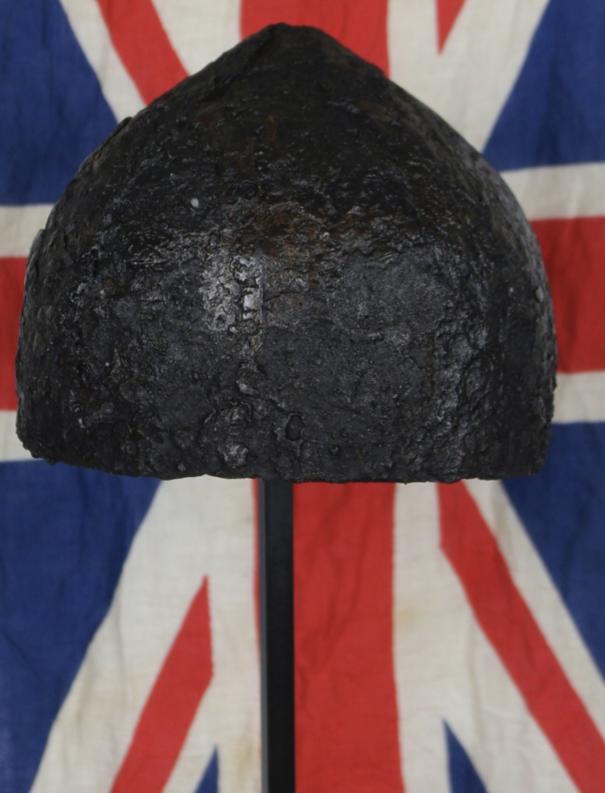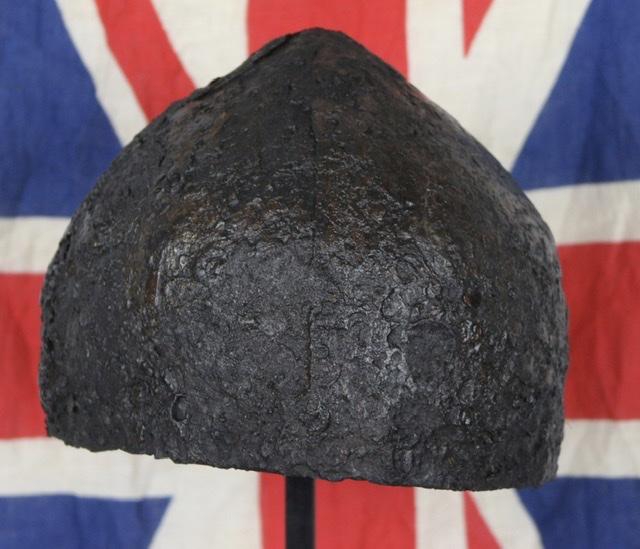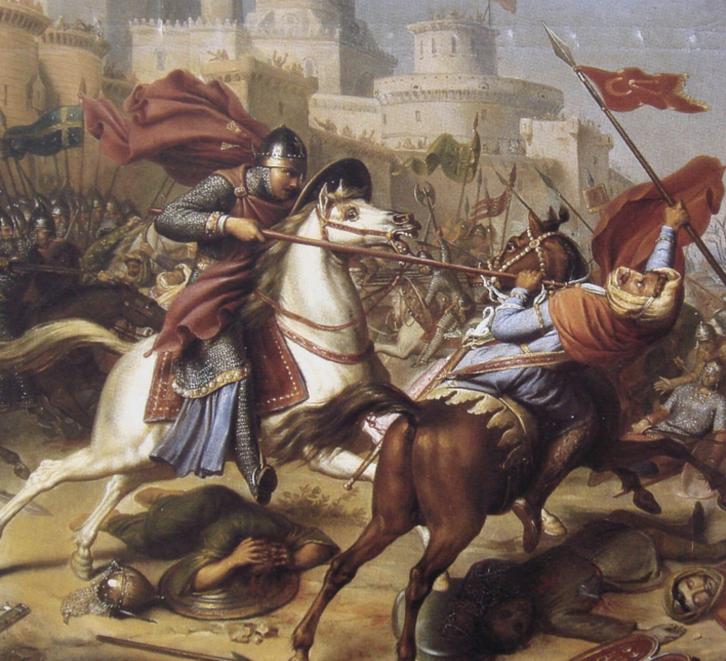An Incredibly Rare, 1000 Year Old, Original Viking-Norsemen Warrior’s, Four Plate Iron Helmet From the Late Viking Raids Era and The King Harold & William the Conquerer Battle of Hastings, & The Same Helmet Used By Knights Throughout The Early Crusades
An incredible museum piece of most notable rarity. Also dominantly used by the Danish Huscarls, the incredibly loyal Norse warriors that formed the personal guard of King Harold.
A fabulous and rare surviving original helmet of the Viking age, around a thousand years old.
In Greenland there is a bronze statue of renown Viking leader Erik the Red wearing his identical helmet. This amazing survivor of a warrior race, famed throughout the world for their extraordinary maritime skills, and notorious acts of raiding throughout most of Europe, and a battle helmet that was made and used a thousand years ago, from the 11th to 12th century AD.
Helmets of this form would have a working life of likely well over 100 years, until styles changed and thus so did helmet forms. An original Viking-Norseman Normannus four-plate iron helmet constructed from curved sections of triangular form, converging at the apex; the bowl contoured so that the back and front plates overlap the side-plates by 1/2 to 1 inch, with iron rivets passing through each overlap to secure them in position; the rivets worked flat into the surface of the helmet, almost invisible from the outside but detectable on the inner surface; the plate-junction at the apex supplied with a small hole, allowing a plume or horsehair streamer to be inserted through a ring; mounted on a custom-made stand. Effectively this is also what is known as a kuman warrior style form of Viking four plate helmet. Helmets of four plate construction came in two distinct forms with or without nasal bar. Erik Thorvaldssona (c. 950 – c. 1003), known as Erik the Red, was a Norse explorer, described in medieval and Icelandic saga sources as having founded the first settlement in Greenland. He most likely earned the epithet "the Red" due to the color of his hair and beard. According to Icelandic sagas, he was born in the Jæren district of Rogaland, Norway, as the son of Thorvald Asvaldsson. One of Erik's sons was the well-known Icelandic explorer Leif Erikson. Vikings, were essentially the direct ancestry of the northern French settled Normans, for, as those as are known today as Normans were not effectively French at all, but the settled Vikings of northern France in Normandy, original from the latin, Normannus land of the Norse or North Men
On 14 October 1066, King Harold fought Duke William's army at the Battle of Hastings
The English army, led by King Harold, took up their position on Senlac Hill near Hastings on the morning of the 14th October 1066. Harold’s exhausted and depleted Saxon troops had been forced to march southwards following the bitter, bloody battle to capture Stamford Bridge in Yorkshire only days earlier.
William's Norsemen attacked with cavalry as well as infantry; in the classic English manner, Harold’s well trained troops all fought on foot behind their mighty shield wall.
The fighting continued for most of the day with the shield wall unbroken. It is said that it was the sight of retreating Normans which finally lured the English away from their defensive positions as they broke ranks in pursuit of the enemy.
Once their carefully organised formation was broken, the English were vulnerable to cavalry attack. King Harold was struck in the eye by a chance Norman arrow and was killed, but the battle raged on until all of Harold’s loyal bodyguard were slain.
The Vikings arrived from Denmark and began raiding in the territory today known as France around 830AD. They found that the current rulers were in the midst of an ongoing civil war. Because the current weakness of the Carolingian empire made it an attractive target, there were several groups, including the Vikings, who were prepared to strike and conquer land and people.
The Vikings used identical strategies in France as they did in England – plundering the monasteries, demolishing markets and towns, imposing taxes or ‘Danegeld’ on the people they conquered, and killing the bishops, which disrupted religious life and caused a severe decline in literacy.
Obtaining the direct involvement of France’s rulers, the Vikings became permanent settlers, although many of the land grants were merely an acknowledgment of actual Viking control of the region. The principality of Normandy was established by Rollo (Hrolfr) the Walker, a leader of the Vikings in the early 10th century. The Carolingian king, Charles the Bald, relinquished land to Rollo in 911, including the lower Seine valley, with the Treaty of St. Clair sur Epte. This was extended to include ‘the land of the Bretons,’ by 933 AD, and became what is known today as Normandy when the French King Ralph granted the land to Rollo’s son, William Longsword.
This battle of Hastings changed the entire course of not just English, but European history. England would henceforth be ruled by an oppressive foreign aristocracy, which in turn would influence the entire ecclesiastical and political institutions of Christendom.
William was crowned king of England on Christmas Day 1066, but it took years more fighting to conquer the whole country. His cruellest campaign was the 'Harrying of the North' in 1069, where he slaughtered the inhabitants of the north-east and destroyed their food stores so that even the survivors starved to death.
The Norman Conquest changed the face of England forever. William ruled as unquestioned conqueror and the Saxons became merely an unpaid workforce for their new lords.
The Norman Conquest also changed the history of Europe – adding the wealth of England to the military might of Normandy made the joint-kingdom a European super-power.
In warfare, it was the start of the age of the knight-on-horseback.
See Curtis, H.M., 2,500 Years of European Helmets, North Hollywood, 1978; Denny, N. & Filmer-Sankey, J., The Bayeux Tapestry, London, 1966; Kirpicnikow, A. N., Russische Helme aus dem Frühen Mittelalter, Waffen- und Kostamkunde, 3rd Series, vol.15, pt.2, 1973; Nicolle, D., Byzantine and Islamic arms and armour; evidence for mutual influence, in: Warriors and their weapons around the time of the Crusades, relationship between Byzantium, the West and the Islamic world, Padstow, 2002, pp.299-325; Menghin, W., The Merovingian Period - Europe Without Borders, Berlin, 2007, pp.326-7, item I.34.4.; D’Amato, R., ‘Old and new evidence on East-Roman helmets from the 9th to the 12th centuries,’ in Acta Militaria Medievalia, 2015, XI, pp.27-157, fig.23, nn.1-2 and pl.1.2.6 kg total, 47cm including stand, helmet: 16cm (18 3/4”"). Helmets of this general profile and form are a long-lived military fashion in the Black Sea region, as evidenced by elements of a 7th-8th century Khazar saddle from the Shilovskiy grave field (Samara region"). A similar helmet is housed in the St. Petersburg Museum (inventory reference PA72), for which D’Amato (2015, pp. 65ff.) proposed an Eastern-Roman origin, based on the interchange of Roman and Khazar military technology. Based on a similar 7th century helmet found with a coin of Heraclius, D’Amato proposed that these helmets were a product of the introduction of Steppe technology in Byzantium. This form of helmet is certainly evident in the iconography of 9th-12th century Eastern-Roman helmets. Fair condition, some restoration. it comes complete with our certificate of authenticity. Picture 9 in the gallery is from an old depiction from the First Crusade of Robert of Normandy at the Siege of Antioch 1097-98 note he wears the same traditional four plate Norman crusades helmet just as this one, followed by an old black and white photo of the tomb of a Knight Hospitaller, Bernard de Faixa, also with the same four plate Norman helmet. The First Crusade to the Holy Land; In what has become known as the Princes' Crusade, members of the high nobility and their followers embarked in late summer 1096 and arrived at Constantinople between November and April the following year. This was a large feudal host led by notable Western European princes: southern French forces under Raymond of Toulouse and Adhemar of Le Puy; men from Upper and Lower Lorraine led by Godfrey of Bouillon and his brother Baldwin of Boulogne; Italo-Norman forces led by Bohemond of Taranto and his nephew Tancred; as well as various contingents consisting of northern French and Flemish forces under Robert II of Normandy eldest son of William the Conqueror, King of England, Stephen of Blois, Hugh of Vermandois, and Count Robert of Flanders. In total and including non-combatants, the army is estimated to have numbered as many as 100,000.
The crusaders marched into Anatolia. While the Seljuk Sultan of Rûm, Kilij Arslan, was away resolving a dispute, a Frankish siege and Byzantine naval assault captured Nicea in June 1097. In marching through Anatolia, the crusaders suffered starvation, thirst, and disease before encountering the Turkish lightly armoured mounted archers at the Battle of Dorylaeum. Baldwin left with a small force to establish the County of Edessa, the first Crusader state, and Antioch was captured in June 1098. Jerusalem was reached in June 1099 and the city was taken by assault from 7 June to 15 July 1099, during which its defenders were massacred. A counterattack was repulsed at the Battle of Ascalon. After this the majority of the crusaders returned home.
The popular image of the Vikings is one of fearsome warriors wearing horned helmets. Many depictions of the Vikings display this particular attribute. However, there is one preserved helmet from the Viking Age and this does not have horns. It was found in the Norwegian warrior’s burial at Gjermundbu, north of Oslo, together with the only complete suit of chain mail from the period.
Parts of helmets have been found in Denmark, including “brow ridges” to protect the warrior’s face in battle. The lack of helmet finds may also be partly due to the fact that no tradition existed of placing them in graves. In addition, helmets were not sacrificed like spears and swords, so we do not come across them in this context either. It is also possible that relatively few Vikings wore helmets and therefore only a small number are found
Helmets with horns?
Depictions of an Iron Age date exist featuring people with horned helmets/heads, such as upon the Golden Horns. Similar images are also known from the Viking period itself.
In the Oseberg burial from Norway, which dates to the early Viking period, a tapestry was found on which horned helmets are also depicted. Does this prove that all Vikings wore the famous helmets with horns? The answer is probably not. However, there is some evidence to suggest that certain warriors wore such headgear. The horned figures on the Golden Horns are berserkers. These were wild warriors, who threw themselves into battle in a trance-like fury. We are also familiar with them from the Icelandic sagas, in which they are amongst the most feared of all Vikings.
It is also possible that such headgear was worn for display or for cultic purposes. In a battle situation, horns on a helmet would get in the way. Such helmets would also have caused problems on board the warships, where space was already at a premium. In addition, none of the contemporary sources mention Vikings wearing horned headgear.
Every single item from The Lanes Armoury is accompanied by our unique Certificate of Authenticity. Part of our continued dedication to maintain the standards forged by us over the past 100 years of our family’s trading, as Britain’s oldest established, and favourite armoury gallery
Code: 23530
11500.00 GBP










